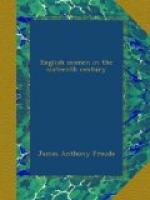This was Elizabeth’s personal feeling. It could not be openly avowed. The States might then surrender to Philip in despair, and obtain better securities for their political liberties than she was ready to ask for them. They might then join the Spaniards and become her mortal enemies. But she had a high opinion of her own statecraft. Her Catholic friends assured her that, once at peace with Philip, she would be safe from all the world. At this moment accident revealed suddenly another chasm which was opening unsuspected at her feet.
Both Philip and she were really wishing for peace. A treaty of peace between the Catholic King and an excommunicated princess would end the dream of a Catholic revolution in England. If the English peers and gentry saw the censures of the Church set aside so lightly by the most orthodox prince in Europe, Parsons and his friends would preach in vain to them the obligation of rebellion. If this deadly negotiation was to be broken off, a blow must be struck, and struck at once. There was not a moment to be lost.
The enchanted prisoner at Tutbury was the sleeping and waking dream of Catholic chivalry. The brave knight who would slay the dragon, deliver Mary Stuart, and place her on the usurper’s throne, would outdo Orlando or St. George, and be sung of for ever as the noblest hero who had ever wielded brand or spear. Many a young British heart had thrilled with hope that for him the enterprise was reserved. One of these was a certain Anthony Babington, a gentleman of some fortune in Derbyshire. A seminary priest named Ballard, excited, like the rest, by the need of action, and anxious to prevent the peace, fell in with this Babington, and thought he had found the man for his work. Elizabeth dead and Mary Stuart free, there would be no more talk of peace. A plot was easily formed. Half a dozen gentlemen, five of them belonging to or connected with Elizabeth’s own household, were to shoot or stab her and escape in the confusion; Babington was to make a dash on Mary Stuart’s prison-house and carry her off to some safe place; while Ballard undertook to raise the Catholic peers and have her proclaimed queen. Elizabeth once removed, it was supposed that they would not hesitate. Parma would bring over the Spanish army from Dunkirk. The Protestants would be paralysed. All would be begun and ended in a few weeks or even days. The Catholic religion would be re-established and the hated heresy would be trampled out for ever. Mary Stuart had been consulted and had enthusiastically agreed.
This interesting lady had been lately profuse in her protestations of a desire for reconciliation with her dearest sister. Elizabeth had almost believed her sincere. Sick of the endless trouble with Mary Stuart and her pretensions and schemings, she had intended that the Scotch queen should be included in the treaty with Philip, with an implied recognition of her right to succeed to the English throne after




